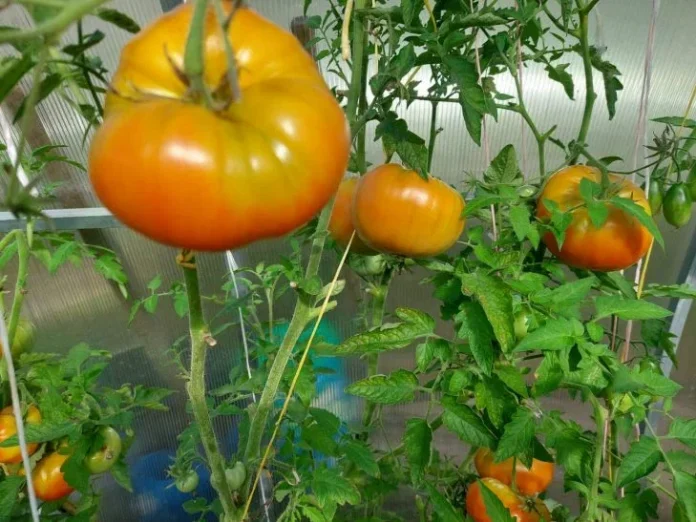Because tomatoes often get sick during the summer season, after the harvest is collected, experienced summer residents always fertilize and disinfect the beds..
But that’s not all that needs to be done – after tomatoes, it is recommended to sow green manure to improve the structure of the soil..
The best option for this particular case is mustard, when sowing which you should take into account several nuances.
After harvesting tomatoes, level the soil with a flat cutter. In this case, the top layer does not need to be removed.
Then you will need to form shallow furrows on the plot. Tamp their bottom and pour mustard seeds there.
The next step will require vermicompost, which must be sprinkled on the seeds along the furrows, covering them with fertilizer. Use compost as the second layer.
The only thing left to do is water the crops generously and wait for the shoots to appear.
It will take about 2-3 weeks for the green manure to grow, after which you can begin to embed them in the soil.
This, again, is convenient to do with a flat cutter, which will have to cut the greens and mix it into the soil. Try to make it so that some of the plants are on the surface, and some are in the soil.
To speed up the process, water the former tomato beds with water, and for the winter sprinkle them with compost or mulch them using mown grass.
Because tomatoes often get sick during the summer season, after the harvest is collected, experienced summer residents always fertilize and disinfect the beds..
But that’s not all that needs to be done – after tomatoes, it is recommended to sow green manure to improve the structure of the soil..
The best option for this particular case is mustard, when sowing which you should take into account several nuances.
After harvesting tomatoes, level the soil with a flat cutter. In this case, the top layer does not need to be removed.
Then you will need to form shallow furrows on the plot. Tamp their bottom and pour mustard seeds there.
The next step will require vermicompost, which must be sprinkled on the seeds along the furrows, covering them with fertilizer. Use compost as the second layer.
The only thing left to do is water the crops generously and wait for the shoots to appear.
It will take about 2-3 weeks for the green manure to grow, after which you can begin to embed them in the soil.
This, again, is convenient to do with a flat cutter, which will have to cut the greens and mix it into the soil. Try to make it so that some of the plants are on the surface, and some are in the soil.
To speed up the process, water the former tomato beds with water, and for the winter sprinkle them with compost or mulch them using mown grass.
Because tomatoes often get sick during the summer season, after the harvest is collected, experienced summer residents always fertilize and disinfect the beds..
But that’s not all that needs to be done – after tomatoes, it is recommended to sow green manure to improve the structure of the soil..
The best option for this particular case is mustard, when sowing which you should take into account several nuances.
After harvesting tomatoes, level the soil with a flat cutter. In this case, the top layer does not need to be removed.
Then you will need to form shallow furrows on the plot. Tamp their bottom and pour mustard seeds there.
The next step will require vermicompost, which must be sprinkled on the seeds along the furrows, covering them with fertilizer. Use compost as the second layer.
The only thing left to do is water the crops generously and wait for the shoots to appear.
It will take about 2-3 weeks for the green manure to grow, after which you can begin to embed them in the soil.
This, again, is convenient to do with a flat cutter, which will have to cut the greens and mix it into the soil. Try to make it so that some of the plants are on the surface, and some are in the soil.
To speed up the process, water the former tomato beds with water, and for the winter sprinkle them with compost or mulch them using mown grass.
Because tomatoes often get sick during the summer season, after the harvest is collected, experienced summer residents always fertilize and disinfect the beds..
But that’s not all that needs to be done – after tomatoes, it is recommended to sow green manure to improve the structure of the soil..
The best option for this particular case is mustard, when sowing which you should take into account several nuances.
After harvesting tomatoes, level the soil with a flat cutter. In this case, the top layer does not need to be removed.
Then you will need to form shallow furrows on the plot. Compact their bottom and pour mustard seeds there.
The next step will require vermicompost, which must be sprinkled on the seeds along the furrows, covering them with fertilizer. Use compost as the second layer.
The rest is easy – water the crops generously and wait for the shoots to appear.
Because tomatoes often get sick during the summer season, after the harvest is collected, experienced summer residents always fertilize and disinfect the beds..
But that’s not all that needs to be done – after tomatoes, it is recommended to sow green manure to improve the structure of the soil..
The best option for this particular case is mustard, when sowing which you should take into account several nuances.
After harvesting tomatoes, level the soil with a flat cutter. In this case, the top layer does not need to be removed.
Then you will need to form shallow furrows on the area
Because tomatoes often get sick during the summer season, after the harvest is collected, experienced summer residents always fertilize and disinfect the beds..
But that’s not all that needs to be done – after tomatoes, it is recommended to sow green manure to improve the structure of the soil..
The best option for this particular case is mustard, when sowing which you should take into account several nuances.
After harvesting the tomatoes, level the soil with a flat cutter. However, you do not need to remove the top layer.
Then you will need to form shallow furrows on the plot. Compact their bottom and pour mustard seeds there.
For the next step, you will need vermicompost, which you need to sprinkle on the seeds along the furrows, covering them with fertilizer. Use compost as the second layer.
The rest is easy – water the crops generously and wait for the shoots to appear.
It will take about 2-3 weeks for the green manure to grow, after which you can begin to plant it in the soil.
Again, it is convenient to do this with a flat cutter, which will cut the greens and mix them into the soil. Try to make it so that some of the plants are on the surface, and some are in the soil.
To speed up the process, water the former tomato beds with water, and sprinkle them with compost for the winter or mulch them using mown grass.


